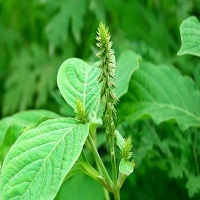Antinociceptive evaluation of an ethanol extract of Achyranthes aspera (agadha) in animal models of Nociception.
Abstract
Achyranthes aspera Linn., known as Chirchira (Hindi), Agadha
(Marathi) is an indigenous herb found in India. It is the basic
composition of many traditional remedies. The herb has been
reported to have variety of activities like antifertility,
antihyperlipidemic, antidiabetic, immunomodulatory,
anticarcinogenic, diuretic and cardiotonic, anti-inflammatory,
antifungal and antibacterial activity. Present study was designed to
evaluate the antinociceptive activity of ethanolic extract of A.
Aspera (EEAA) and to find the phytochemical responsible for this
activity with possible mode of its activity. The antinociceptive
activity of ethanol extract of Achyranthes aspera was investigated in
albino mice. The pharmacological assays used were the tail flick, hot
plate and the formalin-induced pain tests. The extract was given
intraperitoneally at a dose of 400 mg/kg (our earlier study revealed
no activity at the dose 200mg/kg). Pentazocine (10mg/kg body
weight i.p.) was used as standard. Data analyzed by ANOVA test
followed by Dunnett’s test. All the results were expressed as Mean
(±SEM). P <0.05 was considered significant. For formalin test the
percent inhibition was calculated by using formula (C-T)/C × 100
(%). Phytochemical screening revealed presence of triterpenoid
saponins possessing oleanolic acid as aglycone, viz. A & B, alkaloid
achyranthine, water soluble base betaine and steroids. In the tail flick
& hot plate test extract treated animals showed significant analgesic
activity at 30, 60, 90 and 120min. Extract (400 mg/kg i.p.) reduced
the formalin induced pain in both phases (i.e. neurogenic and
inflammatory) by 58.8% and 92.7%, respectively. Ethanol extract of
A.Aspera exhibit central as well as peripheral antinociceptive
activity.
References
Elumalai EK, Chandrasekaran N, Thirumalai
T. et al. Achyranthes aspera Leaf Extracts
Inhibited Fungal Growth. International
Journal of Pharmtech Research.
;1(4):1576-1579.
Dwivedi S, Dubey R, Mehtaz K. Achyranthes
aspera Linn. (Chirchira): A Magic Herb in
Folk Medicine Ethnobotanical Leaflets.
;12: 670-676.
Girach RD, Khan ASA. Ethananomedicinal
uses of Achyranthes aspera leaves in Orissa
(India). International Journal of
Pharmacognosy. 1992;30:113–115.
Satyavati GV, Raina MK, Sharma M.
Medicinal Plants of India, Vol. I, Indian
Council of Medical Research, Cambridge
Printing Works, Delhi.1976; pp 10–14.
Tang W, Eisenbrand G, Achyranthus bidentata
Bl. in Chinese Drugs of Plant Origin,
Springer-Verlag, Berlin. 1992;pp 13–17.
Nehete JY, Deshmukh VN, Shewale VV,
Narkhede MR, Aurangabadkar VM.
Quantitation of oleanolic acid in Achyranthes
aspera . Roots and Leaves extracts by highperformance thin-layer chromatography. Int.
J. Phar. Research and Dev. Online. 2009;7.
Goyal BR, Goyal RK, Mehta AA. Phytopharmacology of Achyranthes aspera : A
Review. Pharmacognosy Reviews.
;1(1):143-150.
Neogi NC, Rathor RS, Shrestha AD, Banerjee
DK. Studies on the anti-inflammatory and
Anti-arthritic activity of ach.yranthine. Ind. J.
Pharmac. 1969;1(3):37-47.
Alam MT, Karim MM, Khan SN.
Antibacterial Activity of Different Organic
Extracts of Achyranthes aspera and Cassia
Alata J. Sci. Res. 2009;1(2):393-398
Khandelwal KR. Practical Pharmacognosy.
(19th edn.) Nirali Prakashan, Pune;2008. p:
-156.
Flecknell PA. Laboratory Animal Anesthesia:
Post operative care. (2nd edn). Academic
Press, Landon.1996, pp:127-157
Chakraborty A, Devi RKB, Rita S,
Sharatchandra K, SinghIndian TIJ.
Preliminary studies on antiinflammatory and
analgesic activities of Spilanthes acmella in
experimental animal models. Indian J
Pharmacol. 2004;36(3):148-150
Turner RA. Screening methods in
Pharmacology. New York: Academic Press.
;pp: 100.
Turner RA. Screening Methods in
Pharmacology. Academic Press, Landon,
.pp.105-108.
Correa CR, Calixto JB. Evidence for
participation of B1 and B2 kinin receptors in
formalin induced nociceptive response in the
mouse. Br. J. Pharm. 1993;110:193–198.
Hunskaar S, Hole K. The formalin test in
mice: dissociation between inflammatory and
non-inflammatory pain. Pain. 1987;30:103-
Bhosale UA, Yegnanarayan R, Pophale P,
Zambare M, Somani RS. Antinociceptive
Screening of an Ethanol Extract of
Achyranthes aspera (Agadha): A Preliminary
study. Inventi Rapid Ethnopharmacology.
;1(2).
De Souza ET, De Lira DP, De Queiroz AC, et
al. The Antinociceptive and AntiInflammatory Activities of Caulerpin, a
Bisindole Alkaloid Isolated from Seaweeds of
the Genus Caulerpa Mar. Drugs 2009;7:689-
Goppelt-Struebe M, Wolter D, Resch K.
"Glucocorticoids inhibit prostaglandin
synthesis not only at the level of
phospholipase A2 but also at the level of
cyclo-oxygenase/PGE isomerase". Br. J.
Pharmacol. 1989;98(4): 1287–95.
Giner-Larza EM, Manez S, Recio MC. et al.
Oleanonic acid, a 3-oxotriterpene from
Pistacia, inhibits leukotriene synthesis and
has anti-inflammatory activity. Eur J
Pharmacol. 2001;428:137-143.
Albena T. Dinkova-Kostova, Karen T. Liby.
et al. Extremely potent triterpenoid inducers
of the phase 2 response: Correlations of
protection against oxidant and inflammatory
stress. PNAS. 2005;102(12):4584–4589.
Chakraborty A, Amudha P, Geetha M, Singh
NS. Evaluation of anxiolytic activity of
methanolic extract of sapindus mukorossi
gaertn in mice. Int. Jr. of Pharma and Bio
Sciences. 2010;1(3):1-8.
Barua CC, Roy JD, Buragohain B, et al.
Anxiolytic effects of hydroethanolic extract
of Drymaria Cordata L Wild. Ind. J Expt. Bio.
;47:.969-973.



